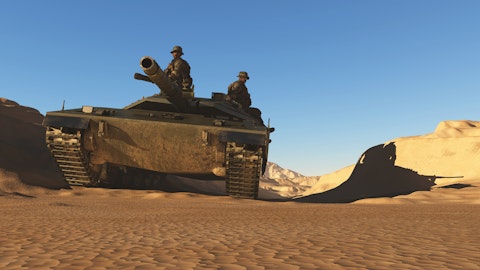And then in some cases on these fixed price development programs, we’re having discussions with customers about either restructuring specifications or altering the requirements in a way that still get capability that’s needed and that’s helpful. But you can get to them, frankly, in a shorter period of time and with a better financial profile. Those conversations continue to go. I’ll tell you that we will, got a handful here that we’re still going to be powering through in 2024 and see that horizon getting better in the next 12 to 18 months as we go through certain milestones, Peter and satisfy some contractual requirements. We then get into a different phase of the agreement and feel better about our ability to go and execute.
Neil Mitchill: Chris, maybe I would add Just a couple of the financial points around our assumptions, financially going into 2024. As you think about the $100 million to $200 million profit increase, the first thing I would say is in ‘23, we had about a $240 million headwind associated with these negative productivity. As you said two-thirds, 70% associated with these fixed-price development programs, principally a couple of them. As we look to ‘24, our assumption is that our absolute value of productivity is zero. So we’ll see about a $200 million improvement year-over-year. We’ll see about $100 million at the midpoint from volume and a little bit of headwind as the lower margins roll through the backlog in ‘24. And that’s what we’ve contemplated both in the ‘24 and the ‘25 outlook.
All of that gets you down to our guide, of course, is that $80 million ahead I talked about. And as you kind of look into ‘25, our productivity assumption is about $100 million step up. So again, this business at one-time generated $300 million, $400 million, $500 million a year of productivity. But we need some time for that to play through to see those kinds of margins. But 2025 would not mark the peak of where we see Raytheon’s margin potential.
Peter Arment: Appreciate it. Thanks, Chris, yes.
Chris Calio: You’re welcome.
Operator: Thank you. Our next question comes from the line of Noah Poponak of Goldman Sachs. Please go ahead, Noah.
Noah Poponak: Hey, good morning, everyone.
Chris Calio: Hey, Noah.
Noah Poponak: Neil, just want to make sure I have the — I guess, the starting point and the implied margin correct in this new $500 million to $550 million, ‘20 to ‘25, so given restatements and the like. So I’m looking at 2020 segment operating margin all in of $8.2 implying that the ‘25 is $13.2 to $13.7, so is that correct? And then can you just talk a little more about getting there from this ‘24 guidance it would seem to either require a pretty nice step up in the Raytheon defense margin or acceleration in the incrementals at Pratt and Collins or all of the above?
Neil Mitchill: Thanks, Noah. So as you kind of look at the multi-year outlook here, what we’ve done at the top end is we’ve tightened up the range a little bit for the RTX sales and margin. We still see Collins and Pratt being within the ranges we talked about. Frankly, the drivers are all the same that we talked about six months ago and the last quarter as well. The aftermarket is going to fuel that. We’re going to get better absorption and we’ll see the benefits of lower spending on investments we’ve been making to drive cost reduction and the benefit of that cost reduction. So if you put all that, that’s going to put Pratt and Collins in that range, probably closer towards the middle of the high-end of that range. And then we just talked about the Raytheon pieces altogether.
So I think at the midpoint, when you take into account the dispositions that we’ve either completed or have announced, you’ll see that our margin assumption at the RTX level is about the same as where we were projecting before these tweaks for the Raytheon recalibration.
Noah Poponak: Okay, and just to make sure I have your — you said to Myles correct, in the $5.7 million of free cash this year and the $7.5 million next year, each of those assumes about $1 billion of positive change in working capital each year, is that right?
Neil Mitchill: That’s correct. And as you think about from ‘23 to ‘24, inventory is going to essentially, our plan is to stay flat, that will be about 80% of what generates that year-over-year working capital benefit in ‘24. And then as you look to ‘25, you know, we’ll see continued improvement in inventory, as well as the benefit of customer advances. So we’ve realized a lot of customer advances over the last couple of years. They will burn down. And then as we see these international orders come back in, you’ll see that pick up in the year ‘25.
Noah Poponak: Okay, thanks very much.
Neil Mitchill: You’re welcome.
Operator: Thank you. Our next question comes from the line of Doug Harned of Bernstein & Company. Please go ahead, Doug.
Doug Harned: Good morning. Thank you. It sounded, from what you said, Chris, that you made some good progress on the AOG profile here for the GTF. But when you look at your customer base, you may have some who find that a high number of AOGs could put their financial performance at risk. Whether or not those issues are caused by Pratt, you could easily be targeted for responsibility. You already have the earlier go-first lawsuit. So how do you think about the risk for you with airlines that could be in a stressed financial position? And maybe more difficult perhaps than how you might normally compensate a customer?
Chris Calio: Yes, thanks Doug. I mean, first of all, I’ll tell you that we are engaging with our customers each and every day to try to figure out how best to support them, whether that’s through induction, whether that’s through special support, whether that’s the spare engine allocation, whatever it may be. And you’re right, Doug, there are some customers out there, 10 to 12, I think, as we’ve talked about before, they’re going to be more impacted than others. There’s some that are all Pratt fleets, whether it be GTF and V2500. So again, working very hard with them to come up with a compensation structure relative to the powdered metal AOG situation. That’s fair, and that can give them a little bit of lift. Obviously, it won’t make up for all of the disruption that they’re having in their fleet and all of the things that they’ve got to do to accommodate for these removals.





